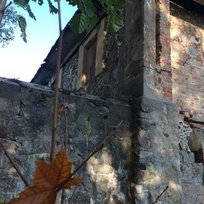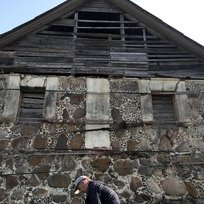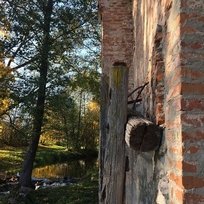A mill once used for grinding grain, currently abandoned, stands in the village of Juodagalviai by the Kančiogina stream.
The Juodagalvių mill belonged to the Krikonis landowners Benislavskis, it was mentioned in the manor inventory books as early as the 18th century (1738 and 1750). The mill's heyday, its golden age, was during the Polish period, during the time of the last tragically deceased landowner Edvardas Benislavskis. He built a new, more efficient Polish turbine, and installed two millstones instead of one. One milled only poor grain for animals, and the second milled flour for bread and cakes. The flour was pickled, and gruce (pearl groats) was produced. The new turbine also made better use of water power. Water was harnessed not only to turn the turbine, but also to operate other auxiliary mechanisms, lifting bags up. Grain, especially good pickled grain, was brought from all the surrounding villages for milling. Two families lived in the mill near the owner, later a Jew who was shot by the Germans during the war, after the war bežanci (refugees) from Russia apparently lived there for some time. In 1838, it went to the Stanevičius family for debts and never again fell into the hands of the Belikovich family. The first decline of the mill was in 1939, when the Bolsheviks came and looted the manor and the mill, the second decline began after the war, during the collective farms. When the Russians returned in 1944, soldiers began to throw explosives into the mill pond, thus fishing the fish. The explosions also irreparably damaged the dam. After the „Naujas kelias“ collective farm was established, the mill broke down, was repaired, turned intermittently, but still worked. After the dam was blown up, a diesel engine was built to turn the mills (later electric motors were installed).
Information updated 2025-12-12






Atsimenu, kolūkių laikais paskutinis malūninikas buvo toks Nikita Pavlov iš Joneliškių kaimo (dabar jau šio kaimo nebėra), 1977 m. jis kažkaip mįslingai žuvo netoli šio malūno...